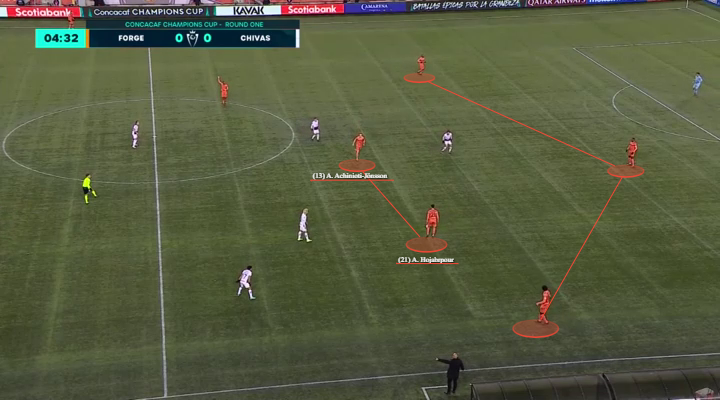Thomas Tuchel’s PSG weren’t brilliant in Ligue 1 this season, but his sacking still came as a relative surprise for many footballing fans. Given his reputation as a tactical innovator at FSV Mainz 05, Borussia Dortmund and even to an extent the Parisians, all clubs (and potentially even national teams) in need of a new manager should be thinking long and hard about the potential to bring the German into their set-up. Alongside analyzing his principles of play, common trends across his managerial career, and potential suitors, we establish where might be the best place for Thomas Tuchel to land next in this three-part tactical analysis. This is our latest analysis into the mind of last season’s UEFA Champions League finalist, Thomas Tuchel.
previous system of play: 4-3-3

If anything, Thomas Tuchel has proven to be a flexible manager, capable of adapting his system (and relatively enough) his style of play to fit his squad. He utilized what could be classified as a 4-3-1-2 or 4-1-3-2 at Mainz, and a variety of formations at Borussia Dortmund including 4-1-4-1, 4-2-3-1 and 3-4-3. At PSG, he was relatively fluid between sticking true to a 4-3-3 that seemed to fit the squad to a tee, but also frequently implemented a more high pressing 4-2-2-2 system. Therefore, Tuchel could theoretically walk into any club or team and identify the strengths and weaknesses of his side before choosing a system to build around. But nailing the German manager down to one specific formation would be impossible, and also rather pointless, given the fluidity of his formations that can change drastically in attack and defense. Perhaps one thing that stands out in all of Tuchel’s sides is the relatively steady presence of a lone defensive midfielder, rather than a double-pivot. We’ve gone with a 4-3-3 here just to represent what he most frequently put together at PSG, and the fact that clubs that might go in for him like Barcelona or Chelsea would probably prefer to play with that system of play over others given a choice. But before getting into more of these potential suitors, we have to take a greater look at Tuchel’s most common principles of play.
principles of play
Before identifying suitors in Part Two, we establish three basic principles of play that Thomas Tuchel has held wherever he’s gone. These include playing out from the back through central midfielders, gegenpressing to cut off central channels, and attack-minded fullbacks.
1. playing out from the back through the cm’s
One of Thomas Tuchel’s most important tactical innovations as a manager has been his use of central midfielders to play out from the back, which is becoming more and more commonplace as tactical trends move along. Tuchel’s “play-makers” during build-up phases are not the centre-backs, or even a talented number ‘6’, but instead the central midfielders. With the Black & Yellows, Tuchel used the likes of Ilkay Gundogan, Gonzalo Castro or Raphael Guerreiro (excellent ball players), to drop in on the right or left, creating a triangular shape to play out, alongside the two centre-backs. Defensive midfielder Julian Weigl would then create an option at the top of the diamond structure, with the goalkeeper as another backwards option if needed. PSG did the exact same thing with Leandro Paredes/Marco Verratti dropping into the back-line and the left “half-space” as it’s known by analysts, as Marquinhos held his central position. It’s not quite positional rotation, but it’s a method of quickly gaining an overload in possession of the ball, disrupting the opposition’s press and ensuring the opposition’s ‘number 10’ can’t have much success if they stick strictly to covering the defensive midfielder. For example, teams playing with a front-two or in a 4-2-3-1, may look to screen passes into Tuchel’s midfield men. But that issue becomes quite difficult should those players move out of position, into wide areas. By doing so, a variety of things can happen, including corridors opening up in central channels for other attackers to drop in and exploit.
This becomes especially difficult for opposition teams to defend when a ball-playing centre-half like Mats Hummels or Thiago Silva is then afforded more time and space, due to the opposition’s desire to track the movement of the shifting central midfielder. We recently talked about this with Arsenal in their re-emergence in the 4-2-3-1 formation, with Granit Xhaka moving into the left half-space during build up phases for the Gunners. It’s something that is becoming more and more commonplace in the game now as tactics evolved. The other obvious benefit is that if a player like Gunodgan or Paredes can get on the ball as early as possible, Tuchel’s side will have one of their best ball-players in possession relatively early in the build-up, hopefully with space and time to pick out the right pass. Further, this four-man diamond unit allows greater flexibility for one of Tuchel’s other prized innovations – attack-minded fullbacks. But before we move onto that, we must talk about the German’s use of what he would probably call “gegenpressing.”
2. pressing from the front
Thomas Tuchel’s FSV Mainz 05 were relentless out of possession, and it’s one of the key reasons he earned the job at Borussia Dortmund, who were perhaps equally relentless. What has been interesting to watch is how well Tuchel has adapted his system to fit pressing trends, his personnel, and his system of play. Mainz utilized a diamond structure in their 4-3-1-2 (sometimes more 4-1-3-2) to effectively shuffle balls out of play or win possession, while pressing in a very systematic way. Deploying a front-two allows a team like Tuchel’s to press either side of the field at a rapid speed, particularly on goal-kicks. There is always one front-man instantly available to cover the space or block off passing options, and so a lone centre-forward does not have to assess or anticipate which side to press. But with an attacking midfielder in behind the front two, it becomes very difficult for the opposition to play passes into central areas. The opposition are forced out wide, where Tuchel’s fullbacks and wide central midfielders attempt to cover the potential gaps in the system. As opposed to pressing in a system like 4-2-3-1 or 4-2-2-2, a 4-3-1-2 may suffer to effectively cover wide areas. But it does provide unique benefits to cutting off central channels and forcing the opposition out wide. Although teams naturally look to attack with width regardless, this can be positive in both shuffling the opposition out of play, and away from goal. Further, it is also suggested that Tuchel’s shape actually resembled more of a 4-1-3-2 in certain phases of the game, including when pressing, so their ability to cover wide areas was likely more than enough.
At Dortmund, similar methods of pressing from the front were achieved in the 4-1-4-1. In a high-pressing system though, it was perhaps more crucial that Tuchel’s front five regained possession, given the potential gap between the midfield four and the midfield one. If the side had opted for a low block, this would not have been too much of a concern given the amount of time they would have to recover position and shift/slide with the play. In a high-press, Dortmund needed to be resistant to opposition teams attempting to play through them, due to the potential holes in their formation to be exploited if they failed. Luckily, they saw much success in this approach. Forcing their opposition out wide, they were often able to regain possession and go on the counter attack (as Dortmund sides have done so well over the years), or force their opposition into longer passes, recycle play and begin the first principle of play we mention.
At PSG, Tuchel perhaps utilized a 4-3-3 to the benefit of his players more so than to the benefit of its ability to press the opposition. When he really wanted to press his opposition, he adopted a 4-2-2-2 system, which allowed for some great free-flowing football, and also a solid structure to defend from the front. The benefits of two strikers in the press were still in tact, but now Tuchel had two men to cut off passing lanes in central areas rather than the one that he had at Mainz. Opposition teams were forced out wide, forced into mistakes or forced into longer passes, where again Tuchel was able to restart Principle of Play #1. Notably however, the 4-2-2-2 requires attack-minded fullbacks to push up with the play, as pressing teams usually need to do regardless. If the opposition are able to switch the field quickly, the high nature of the fullbacks can cause disruption and issue to the system. But it can also aid in Tuchel’s ability to implement his third principle of play.
3. attack-minded fullbacks
In correspondence with both of his other principles that we have described, Thomas Tuchel has frequently used what can be described as “attack-minded fullbacks”. These, in simple terms, are fullbacks who are attack-minded. In more complex terms, they are players who frequently gallop up and down the right and left wings, to overlap inverted wingers or wide central midfielders. I personally enjoyed watching Tuchel’s Dortmund most often when they were playing with a back-three, due to the excitement he got out of wing-backs like Raphael Guerreiro, Erik Durm or Lukasz Piszczek. Quite creatively, he also used Gonzalo Castro in this role as a key chance creator down the wing. At Mainz, the benefits of his attack-minded fullbacks were perhaps more obvious. The 4-3-1-2 can be thought of as a formation that can lack the necessary width needed to hurt opponents in possession, and so having fullbacks who add to the attack creates that width. It can also fill necessary holes when the 4-3-1-2 changes shape to look more like a 4-1-3-2, minimizing the gap in between the midfield three and midfield one by creating more of a 2-3-3-2 system. This can then be effectively used to press the opposition team should they lose possession, but also create overloads in wide areas with what can look on paper like two lines of wingers.
At Borussia Dortmund, Tuchel’s men excited in a 4-1-4-1 formation, with free flowing fullbacks like Lukasz Piszczek and Raphael Guerreiro, advancing into the opposition’s half to help aid overlaps in the attack and also cover the necessary space. Again, a lone central midfielder may have a tough job on their hands out of possession, and fullbacks pushing up in a sort of 2-3-5 structure can mitigate this concern, particularly in defensive transitions. Tuchel also frequently deployed wingers who weren’t really out and out wingers, such as Henrikh Mkhitaryan and Marco Reus, allowing his fullbacks to share greater width-spreading responsibilities, as his wingers cut inside and made their magic happen. Whilst at PSG, the same principles of play could be found, with the likes of Angel di Maria and Neymar operating out wide and frequently roaming into central areas. Perhaps this is where Tuchel really went all in on attack-minded fullbacks though, given the stature of PSG as a big fish in a reasonably small pond. Juan Bernat was a perfect addition for Tuchel in achieving this desire, while Thomas Meunier and Thilo Kehrer offered the German enough fluidity down the right. Tuchel never really had box to box midfielders and even those capable of fulfilling such a role like Ander Herrera and Idrissa Gueye were relatively defensive-minded, having a desire to hold the midfield more than push-on and create in attack. That burden and responsibility fell to the fullbacks, allowing PSG to create overlaps and overloads in wide areas. Simultaneously, it allowed greater freedom for players like Neymar, Kylian Mbappe and Angel di Maria to get on the ball in central areas.
Before you go, we just launched our brand new Instagram account. If you enjoyed this article, be sure to help us grow! The Mastermind Site (@mastermindsite)
So there it is! Thomas Tuchel’s Principles of Play in our Tactical Analysis series of where he might end up next. Be sure to check out Part Two, where we analyze each potential suitor and Part Three, where we examined why the German would fit Chelsea so well. Be sure to check out more of our Tactical Analyses and follow on Twitter to never miss an update @mastermindsite. Thanks for reading and see you soon!
You might also enjoy…
-> Why Thomas Tuchel is the Perfect Fit for Chelsea – Tactical Analysis
-> Thomas Tuchel – Tactical Analysis – Where Should He Land Next?
-> Thomas Tuchel – Paris Saint Germain – Tactical Analysis








15 thoughts on “Thomas Tuchel’s Principles of Play – Tactical Analysis”